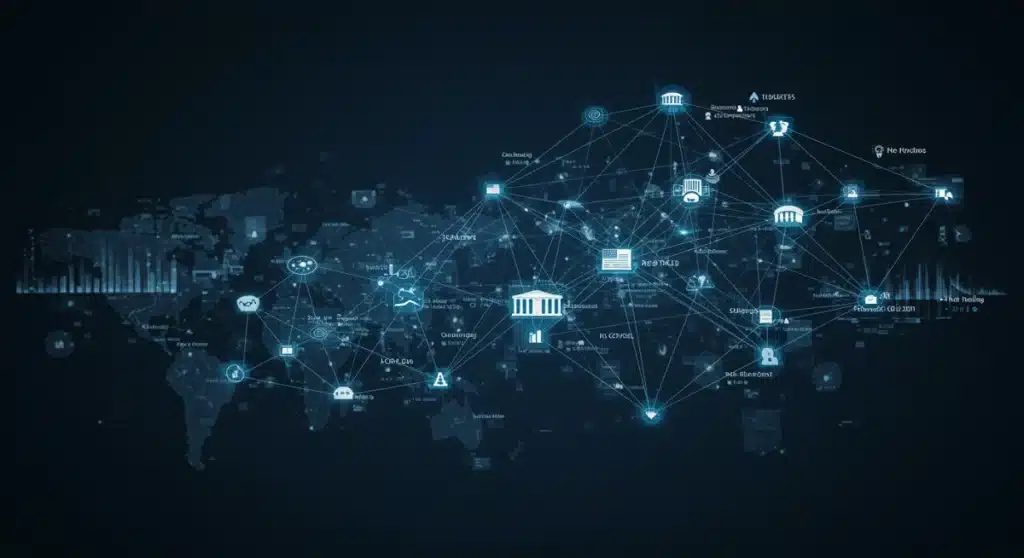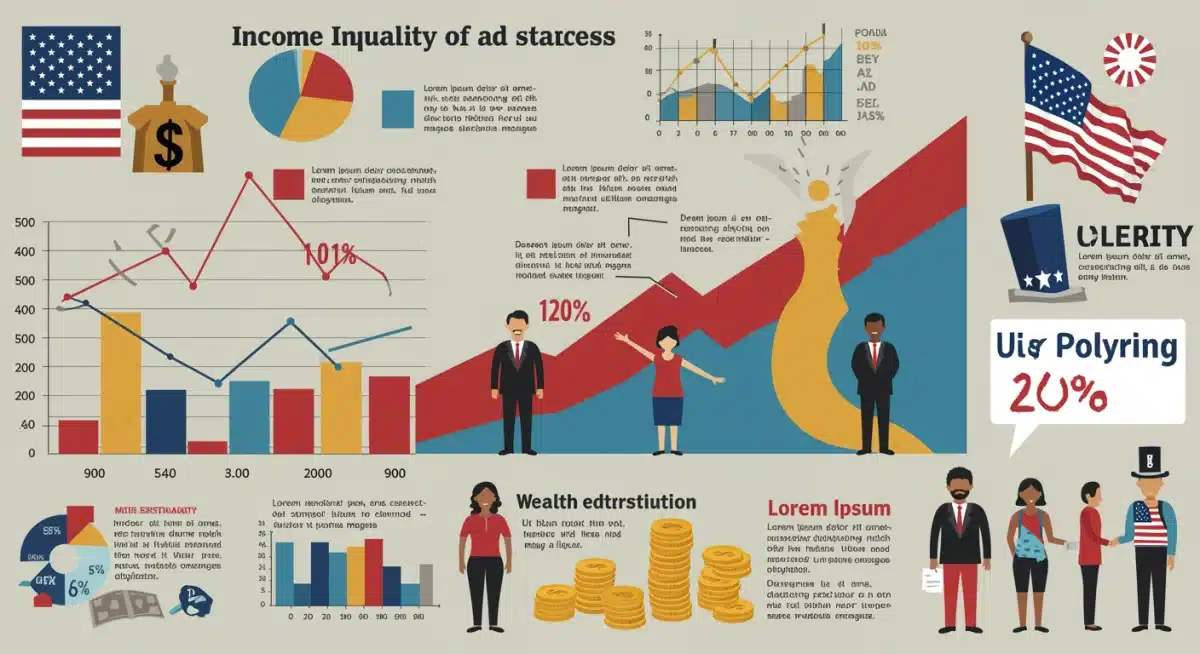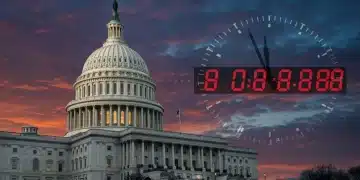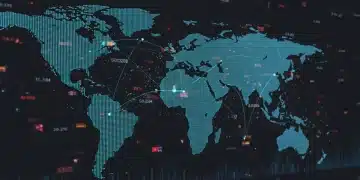Unreported Political Trends Shaping 2025 US Policy

Seven crucial, largely unreported political trends are already shaping US policy for 2025, from evolving geopolitical alliances to domestic technological shifts, demanding closer attention from informed citizens.
As the political discourse often fixates on daily headlines, a deeper current of transformations is silently reshaping the landscape of American governance. Beyond the headlines: 7 unreported political trends shaping 2025 US policy are already at play, subtly influencing decisions that will define the nation’s future, often escaping mainstream media scrutiny.
The Silent Rise of Algorithmic Governance
The increasing integration of artificial intelligence and machine learning into governmental processes is one of the most profound yet under-discussed shifts. This isn’t just about data analysis; it’s about algorithms beginning to inform, and in some cases, directly influence policy decisions, from resource allocation to predictive policing. The implications for transparency, accountability, and equity are immense, yet public awareness remains low.
While often touted for efficiency, algorithmic governance introduces new layers of complexity and potential bias. The datasets feeding these systems can perpetuate existing societal inequalities, and the intricate nature of their operations makes auditing challenging. As these systems become more sophisticated, their impact on the lives of ordinary citizens will only grow, demanding a more proactive approach to oversight and ethical guidelines.
Automated Decision-Making and Its Challenges
The move towards automated decision-making in government agencies presents a dual-edged sword. On one hand, it promises faster, more consistent outcomes. On the other, it risks embedding systemic biases and reducing human discretion where it might be most needed.
- Bias Amplification: Algorithms trained on historical data can inadvertently amplify existing societal biases, leading to discriminatory outcomes in areas like criminal justice or social welfare.
- Transparency Deficit: The proprietary nature of many AI systems or the sheer complexity of their internal logic often creates a ‘black box’ problem, making it difficult to understand how and why certain decisions are made.
- Accountability Gaps: When an algorithmic system makes a flawed decision, pinpointing responsibility becomes a significant challenge, complicating legal and ethical frameworks.
The future of governance will heavily depend on how effectively policymakers can harness the power of AI while mitigating its inherent risks. Developing robust ethical frameworks, ensuring diverse and unbiased training data, and establishing clear accountability mechanisms are paramount. Without these safeguards, the silent rise of algorithmic governance could lead to unintended consequences, further exacerbating social divides and eroding public trust.
Geopolitical Realignment: Beyond Traditional Alliances
The global stage is undergoing a profound transformation, moving beyond the binary Cold War alignments and even the post-Cold War unipolar moment. We are witnessing the emergence of fluid, issue-specific coalitions and a re-evaluation of long-standing alliances. This shift is not always visible in high-profile summits but is playing out in subtle diplomatic maneuvers and economic reorientations.
Nations are increasingly prioritizing national interests over ideological solidarity, leading to pragmatic partnerships that defy conventional categorization. This trend challenges US foreign policy, requiring a more agile and adaptive approach to international relations. The traditional tools of diplomacy and defense may prove insufficient in navigating this complex, multi-polar world.
The Rise of Non-Aligned Powers and Economic Blocs
Several nations are asserting greater independence, forming new economic blocs and security partnerships that do not solely orbit around Washington D.C. or Beijing. This diversification of global power centers impacts trade routes, technological standards, and international norms.
- BRICS Expansion: The growing influence and membership of groups like BRICS signal a concerted effort by emerging economies to create alternative financial and political structures, reducing reliance on Western institutions.
- ASEAN’s Strategic Autonomy: Southeast Asian nations are increasingly balancing relations with major powers, refusing to be drawn exclusively into one sphere of influence, thereby enhancing their collective bargaining power.
- African Union’s Global Presence: The AU is asserting itself as a significant diplomatic actor, forging partnerships with various global players and advocating for African interests on the international stage.
The implications for US foreign policy are substantial, demanding a nuanced strategy that acknowledges these new power dynamics. Engaging with these diverse blocs on their own terms, rather than through a traditional lens of alignment or opposition, will be critical for maintaining influence and promoting stability in an increasingly fragmented world. Understanding these evolving geopolitical trends is essential for shaping effective US policy in 2025.
The Quiet Erosion of Local Media and Civic Engagement
While national political debates dominate headlines, the slow but steady decline of local journalism is having a profound, unreported impact on US policy at the grassroots level. As local newspapers shutter and newsrooms shrink, communities lose a vital source of information, accountability, and civic cohesion. This vacuum is often filled by misinformation or national narratives that fail to address local specificities.
The erosion of local media directly correlates with a decrease in civic engagement. Without robust local reporting, citizens are less informed about local elections, school board decisions, and municipal policies that directly affect their daily lives. This creates fertile ground for apathy and allows special interests to operate with less scrutiny, ultimately influencing state and federal policy through less transparent channels.
Impact on Local Elections and Accountability
The absence of strong local media weakens the democratic process at its foundational level. Local elections, which often have a more direct impact on residents, receive less coverage, leading to lower voter turnout and less informed decisions.
- Reduced Oversight: With fewer journalists, local government bodies, school boards, and public utilities face less scrutiny, increasing the potential for corruption and inefficiency.
- Information Gaps: Citizens struggle to find reliable information about local issues, making it harder to hold elected officials accountable or participate meaningfully in community decisions.
- Rise of ‘Ghost Newspapers’: Many remaining local papers are mere shells, owned by large corporations, producing minimal original content and often relying on syndicated national news, further detaching them from local concerns.
The long-term consequences of this trend are significant for the health of US democracy. As local issues become less visible, the connection between citizens and their government weakens, potentially leading to a more disconnected and less representative policy-making process, influencing state and national political trends.

The Weaponization of Information and Hybrid Threats
The concept of hybrid warfare has evolved beyond state-sponsored cyberattacks to encompass a broader, more insidious weaponization of information itself. This trend, often operating below the threshold of conventional conflict, is reshaping domestic and international policy. Foreign and domestic actors are increasingly employing sophisticated psychological operations, deepfakes, and targeted disinformation campaigns to sow discord, influence elections, and undermine public trust in institutions.
This constant barrage of manipulated information challenges traditional notions of national security and domestic stability. Policymakers are grappling with how to defend against threats that exploit cognitive biases and leverage social media algorithms, without infringing on free speech. The battle for narrative control is becoming as crucial as military might, demanding innovative responses that are still largely in their nascent stages.
Challenges to Democratic Resilience
The weaponization of information poses a direct threat to the resilience of democratic societies. By eroding trust in factual reporting and shared realities, it makes consensus-building difficult and polarizes public opinion.
- Electoral Interference: Disinformation campaigns can sway public opinion, suppress voter turnout, or promote specific candidates, thereby undermining the integrity of democratic elections.
- Societal Polarization: Targeted narratives amplify existing divisions, making compromise and constructive dialogue increasingly difficult, leading to social fragmentation.
- Erosion of Trust: Constant exposure to manipulated information can lead to cynicism towards all sources of information, including legitimate news organizations and government communications.
Addressing this complex challenge requires a multi-faceted approach, including media literacy education, technological solutions to detect deepfakes, and international cooperation to counter state-sponsored propaganda. Failure to effectively counter the weaponization of information could lead to a perpetually destabilized political environment, significantly impacting US policy in 2025.
Demographic Shifts and Their Unseen Political Weight
Beyond the well-publicized shifts in racial and ethnic composition, subtler demographic changes are quietly reshaping the political landscape and policy priorities. These include internal migration patterns, the aging of the population, and evolving family structures, all of which exert pressure on social services, infrastructure, and political representation in ways not always captured by national polls.
For instance, the movement of populations to exurban and rural areas, driven by remote work and affordability, is altering the electoral map and bringing new demands for broadband access, healthcare, and educational resources to previously underserved regions. Similarly, the growing proportion of older Americans impacts everything from healthcare spending to retirement policies, often with less vocal advocacy than other demographic groups.
Generational Divides and Policy Priorities
Differing priorities and experiences across generations are creating new fault lines in policy debates. While youth activism often garners attention, the quiet power of older demographics in voting patterns and resource consumption is a significant, yet often understated, political force.
- Healthcare and Social Security: The aging population places increasing strain on social security and Medicare, leading to ongoing intergenerational debates about funding and benefits.
- Education and Housing: Younger generations face challenges related to student debt and housing affordability, driving demands for different types of government intervention compared to previous generations.
- Climate Change: Generational attitudes towards environmental policy vary significantly, with younger voters often prioritizing aggressive climate action, while older voters may focus on economic stability.
Understanding these nuanced demographic shifts is crucial for policymakers aiming to craft inclusive and effective policies. Ignoring these underlying currents risks creating policies that fail to address the actual needs of a diverse and evolving populace, thereby fueling future political instability and shaping the unreported political trends that will define 2025 US policy.

The Growing Influence of Non-State Actors in Policy
While governments remain central, the influence of non-state actors in shaping US policy is expanding in ways that are often overlooked. This includes not only traditional NGOs and think tanks but also powerful tech companies, philanthropic organizations, and even decentralized online communities. These entities wield significant soft power, influencing public opinion, setting policy agendas, and even circumventing traditional diplomatic channels.
Tech giants, for example, often set de facto global standards through their platforms and services, impacting privacy, free speech, and economic activity far beyond national borders. Similarly, well-funded philanthropic organizations can fund research, advocacy, and pilot programs that directly influence legislative outcomes without the direct accountability of elected officials. Their growing reach presents both opportunities for innovation and challenges for democratic oversight.
Lobbying and Advocacy in the Digital Age
The methods of influencing policy have diversified dramatically, moving beyond traditional Capitol Hill lobbying to include sophisticated digital advocacy campaigns and direct engagement with policymakers facilitated by technology.
- Digital Grassroots Mobilization: Online platforms enable non-state actors to quickly mobilize large groups of citizens, pressuring policymakers on specific issues and shaping public discourse.
- Tech Company Influence: Major tech companies influence policy through their control over information flows, their role in critical infrastructure, and their substantial lobbying efforts on issues like regulation, antitrust, and data privacy.
- Philanthropic Policy Initiatives: Large foundations fund extensive research and advocacy efforts, often shaping the intellectual framework for policy debates and promoting specific solutions to complex problems.
The increasing power of these non-state actors necessitates a re-evaluation of how policy is made and who holds influence. Ensuring transparency and accountability from these powerful entities will be a critical challenge for democratic governance in the years to come, profoundly impacting the political trends that will define US policy in 2025.
The Silent Struggle for Critical Resources and Supply Chains
Beneath the surface of trade disputes and economic reports lies a silent, intensifying struggle for control over critical resources and the supply chains that deliver them. This isn’t just about oil; it encompasses rare earth minerals essential for modern technology, fresh water, agricultural land, and even the intellectual property behind advanced manufacturing. Nations, including the US, are increasingly recognizing vulnerabilities in their supply chains, leading to a quiet but urgent push for reshoring, diversification, and strategic alliances.
This trend is driven by geopolitical rivalries, climate change impacts, and the lessons learned from recent global disruptions. The implications for national security, economic stability, and international relations are profound. Policies aimed at securing these resources – from domestic subsidies to international agreements – will become a central, though often unpublicized, feature of US governance in the coming years.
Strategic Dependencies and National Security
The reliance on foreign sources for essential goods and components creates strategic dependencies that can be exploited by rival powers or disrupted by unforeseen events, posing a direct threat to national security.
- Semiconductor Shortages: The global reliance on a few key manufacturers for advanced semiconductors highlights a critical vulnerability, driving policies aimed at boosting domestic chip production.
- Rare Earth Minerals: The near-monopoly of certain countries on rare earth elements, vital for defense and green technologies, is prompting efforts to diversify sourcing and develop alternative materials.
- Food Security: Climate change and geopolitical instability threaten global food supplies, leading to increased focus on domestic agricultural resilience and strategic food reserves.
The US is facing increasing pressure to de-risk its supply chains and reduce strategic dependencies. This will involve a complex interplay of industrial policy, trade agreements, and diplomatic efforts. The success of these initiatives will be crucial for maintaining economic competitiveness and national security, making this one of the most significant unreported political trends shaping 2025 US policy.
| Key Trend | Brief Description |
|---|---|
| Algorithmic Governance | AI increasingly informs and influences policy decisions, raising questions about bias and accountability. |
| Geopolitical Realignment | Emergence of fluid, issue-specific global coalitions challenging traditional alliances. |
| Local Media Erosion | Decline of local journalism impacts civic engagement and grassroots accountability. |
| Weaponized Information | Sophisticated disinformation campaigns undermine trust and influence elections. |
Frequently Asked Questions About Unreported Political Trends
Unreported political trends are subtle, often long-term shifts in political, economic, and social dynamics that don’t always make mainstream headlines but significantly influence future policy. They are crucial because they offer a deeper understanding of the forces shaping national decisions, allowing for better preparedness and more informed civic engagement.
Algorithmic governance impacts US policy by integrating AI into government operations, influencing decisions from resource allocation to predictive policing. While promising efficiency, it raises concerns about embedded biases, transparency deficits, and accountability gaps, potentially leading to discriminatory outcomes if not carefully managed and regulated.
The decline of local media is an ‘unreported political trend’ because its impact is gradual and often overshadowed by national news, yet it profoundly weakens local accountability, civic engagement, and informed decision-making at the community level. This vacuum can allow special interests to influence policy with less public scrutiny, affecting broader political landscapes.
‘Hybrid threats’ in the context of weaponized information refer to the use of sophisticated psychological operations, deepfakes, and targeted disinformation campaigns by state and non-state actors. These tactics aim to sow discord, influence elections, and undermine public trust in institutions, operating below conventional conflict thresholds to reshape policy and societal stability.
Demographic shifts, such as internal migration, population aging, and evolving family structures, quietly influence future US policy by creating new demands for social services, infrastructure, and political representation. These changes exert pressure on policymakers for issues like healthcare, housing, and education, often leading to shifts in electoral maps and policy priorities that are not always immediately apparent.
Conclusion
The political landscape of the United States in 2025 will be shaped not only by the headlines that grab immediate attention but by a confluence of deeper, often unseen forces. From the silent integration of artificial intelligence into governance to the quiet erosion of local media, these seven unreported political trends signify a complex evolution in how power is exercised, information is consumed, and policies are formed. Understanding these underlying currents—the geopolitical realignments, the weaponization of information, evolving demographics, the growing influence of non-state actors, and the struggle for critical resources—is paramount for any informed citizen or policymaker. By looking beyond the daily news cycle, we gain invaluable insider knowledge into the true forces at play, enabling us to better comprehend the challenges and opportunities that lie ahead for US policy. Engaging with these nuanced realities is not just an academic exercise; it is a vital step toward fostering a more resilient, equitable, and democratic future.





